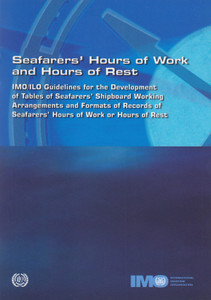
This publication is a guide to the nature of fatigue and its causes. It outlines preventative measures and countermeasures designed to help combat fatigue on board ship.
Approved by the Maritime Safety Committee of the International Maritime Organization (IMO), the guidelines in this publication include modules addressing the issue of fatigue from different angles: the company, the seafarer, awareness and training, ship design, and the Administration and port State authorities.
It includes examples of sleep and fatigue monitoring tools and of fatigue event report information.
Foreword
The Maritime Safety Committee (MSC) of the International Maritime Organization (IMO), at its seventy-first session (19 to 28 May 1999), considered the issue of human fatigue and agreed to develop practical guidance to provide appropriate information on fatigue to all parties concerned.
Consequently, at its seventy-fourth session (30 May to 8 June 2001), MSC approved MSC/Circ.1014 on Guidance on fatigue mitigation and management.
MSC, at its ninety-fourth session (17 to 21 November 2014), agreed to undertake a revision of the Guidance on fatigue mitigation and management and instructed the Sub-Committee on Human Element, Training and Watchkeeping (HTW) to conduct the review.
Accordingly, MSC, at its 100th session (3 to 7 December 2018), approved the Guidelines on fatigue, finalized by the HTW Sub-Committee, at its fifth session (16 to 20 July 2018). They are composed of self-contained modules addressing the issue of fatigue from different angles: the company, the seafarer, awareness and training, ship design, and the Administration and port State authorities.
In approving the Guidelines, IMO Member States were invited to:
–– bring the Guidelines to the attention of their maritime Administrations and all stakeholders, including seafarers, companies, naval architects/ship designers and training providers;
–– use the Guidelines as a basis for disseminating information on fatigue (for example by means of pamphlets, video training modules, seminars and workshops); and
–– take the Guidelines into consideration when determining minimum safe manning.
Companies were strongly urged to take the issue of fatigue into account when developing, implementing and improving safety management systems under the International Management Code for the Safe Operation of Ships and for Pollution Prevention (ISM Code).
The
Guidelines
contained
in
this
publication
supersede
the
Guidance
on
fatigue
mitigation
and
management
(MSC.1/Circ.1014),
approved
on
12
June
2001,
and
published
in
2002
as
the
first
edition
of
this
book.
Foreword
List of acronyms and abbreviations
Introduction
Module 1 – Fatigue
Module 2 – Fatigue and the company
Module 3 – Fatigue and the seafarer
Module 4 – Fatigue awareness and training
Module 5 – Fatigue and ship design
Module 6 – Fatigue, the Administration and port State authorities
Appendix 1 – Examples of sleep and fatigue monitoring tools
Appendix 2 – Example of fatigue event report information
As a specialised agency of the United Nations, IMO is the global standard-setting authority for the safety, security and environmental performance of international shipping. Its main role is to create a regulatory framework for the shipping industry that is fair and effective, universally adopted and universally implemented.
In other words, its role is to create a level playing-field so that ship operators cannot address their financial issues by simply cutting corners and compromising on safety, security and environmental performance. This approach also encourages innovation and efficiency.
Shipping is a truly international industry, and it can only operate effectively if the regulations and standards are themselves agreed, adopted and implemented on an international basis. And IMO is the forum at which this process takes place.
- Number of Pages:
- 91
- ISBN:
- 9789280100471
- Published Date:
- December 2019
- Binding Format:
- Paperback
- Book Height:
- 0 mm
- Book Width:
- 0 mm
- Author:
IMO
- Preview:
- Yes
- Publication Date:
- December 2019





